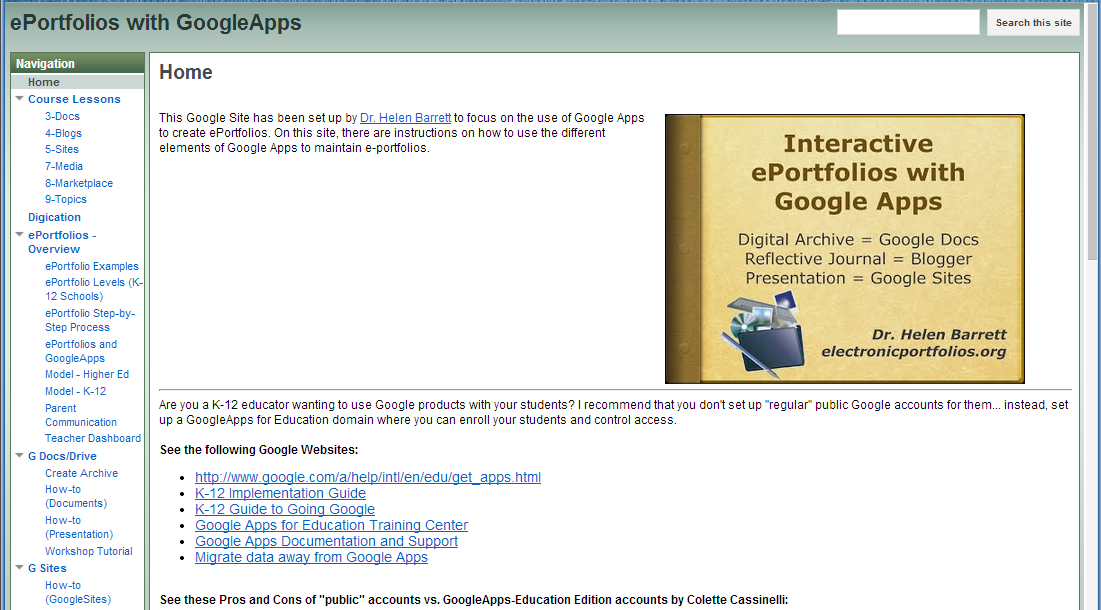
Question for ISTE Standard 3: How can I demonstrate fluency in technology and effective use of current and emerging digital tools with resources to support student success and innovation? The articles I chose are “Balancing the Two Faces of E-Portfolios”, H. Barrett and “Digital fluency: Building success in the digital age.
I found that the article Digital Fluency made sense, Briggs & Makice (2011) wrote “…the development and maintenance of digital abilities requires practice. First-hand experience is critical to learning, the process to become fluent demands an investment of time and patience…” Not only is this applicable to the students, but even more for the educator who is trying to use the technology to meet the educational outcome. E-portfolios allow us to demonstrate and practice our current technology skills, and also to gradually incorporate new and developing technologies.
When looking for better ways for students to document and demonstrate their growth in a class over time, E-portfolios seem to have several advantages. They give students the opportunity to build a positive digital identity and publicly share with peers, parents, and others in the learning process. The creation of e-portfolio’s should gradually move over time from teacher-directed to student-directed and can be implemented at any age, depending on the technology skills of both the students and the teachers, and adequate technology access (Barrett, 2011).

The traditional or beginning e-portfolios with technology, allow students to create a digital collection of their work. Students can organize their work as it addresses each learning outcome, it then can be used to demonstrate the learning process through artifacts. Students can demonstrate their individuality by choosing the pieces they wish to use as documentation and then explaining how it meets that standard. They then can be used to create reflections and provide the opportunity to visualize relationships between concepts.
The key aspect of an e-portfolio is the student’s explanation or reflection of learning, documenting why it was chosen and what they learned from the creationprocess. The best reflections take place at multiple points, when the piece is made, and when and why they included it in their e-portfolio, are two examples. Helen Barrett writes that even the process of adding their pieces to the portfolio through simple hyperlinking may “lead to higher levels of thinking about learning, or meta-cognition” (Barrett, 2011).
The teacher’s in my learning circle and myself believe that reflection is important to learning. We also see e-portfolios documenting and tracking students’ progress, allowing us to answer the time old question of “What did you do in school today?”, and furthermore ending “The dog ate my homework” or “I lost it”. Much better than the old file folder or binder, they are coming alive with the ability to incorporate audio and video allowing for a better representation of individual identity.
As new technologies and applications are being created, we find that many of them are social networks. These can easily be incorporated in education, and Dr. Barrett believes “the boundaries are blurring between e-portfolios and social networks.” With all the technology that is available to document our learning, the iPads and chrome books, there is so much potential. The question asked is “are we beginning to see lifelong interactive portfolios emerging as “mash-ups” in the Web 2.0 cloud, using blogs or wikis or Twitter, Facebook or Ning, Flickr or Picasa or YouTube, etc.?” (Barrett 2011) Just think of the possibilities.
My student portfolios definitely look at the different processes and products of what they are learning. I believe integrating more audio and video, and incorporating the blogs and twitters and wikis into the portfolios will improve student engagement. Our portfolios will be looking much different, the requirements for reflecting will be changing, and they will become interactive portfolios.

(Full reflections on assignment pages)
Barrett, H. (2011). Balancing the Two Faces of E-Portfolios. Retrieved from http://electronicportfolios.org/balance/Balancing2.htm
Briggs, C., & Makice, K. (2011). Digital fluency: Building success in the digital age.
Kumar, S. & Vigil, K. (2011). The Net Generation as Preservice Teachers: Transferring Familiarity with New Technologies to Educational Environments. Journal of Digital Learning in Teacher Education, 27(4), 144-153.
TEDxASB – Helen Barrett [Video file]. (2010, February 25). Retrieved from https://www.youtube.com/watch?v=ckcSegrwjkA.
Hi Shannon,
I like the quote you chose from Barrett which stated that e-portfolios can be utilized at any age depending on the technology skills and access of both the students and teachers. As teachers, we know that it can be hard to break out of our comfort zones. If you are not familiar with e-portfolios and ways to integrate technology, you most likely are going to use a different format of teaching. Obviously, we see the same thing in students, but it is our job to expose them to these skills so that they can be successful and comfortable with technology-use. I agree that e-portfolios are a wonderful way for students and teachers to track progress. Student reflections are an important part of learning and can be easily shown through e-portfolios.
Thanks!
Callie
Hi Shannon,
This is awesome! First, I love that you recognize that digital abilities require practice, time and patience for both the student and educator. It’s a nice reminder that we are all learning and that it takes time. Second, the implementation of e-portfolios sounds like something all high school students could benefit from. I am a big fan of the reflection process, and by being digital, nothing could get lost.
Years ago (when I was a student), my school attempted to keep portfolios that followed the students throughout high school. On the first day of school, we were supposed to find our previous English teacher, pick up our portfolio from the file cabinet, and bring it to our new English teacher’s room. I clearly remember adding assignments to this folder then sifting through it, adding half sheet reflections to certain documents stating why I chose the piece and what I learned. It was great! However, I remember doing this for about two years then…what the heck happened to those folders? An e-portfolio would make this process so much easier and allow students to practice working with technology.
I think you have also found a solution to the ol’ “we didn’t do anything in that class” statement–which of course is always false. Allowing time for reflection and keeping this record would definitely help my students take responsibility for their learning. Thank you for sharing these resources and thoughts!
Sara H.
Thank you Sara and Callie,
I was happy to see your comments about reflection in learning, I agree with both of you on the importance. It is not enough to post objectives of my lessons on the board and think I am done, and assessments can tell me some things about what students retained. But reflection is the key to my students and I understanding what they have learned and how they have connected it to previous learning. It’s not just hopping from concept to concept, regurgitating what I am teaching, but understanding how they relate to each other.